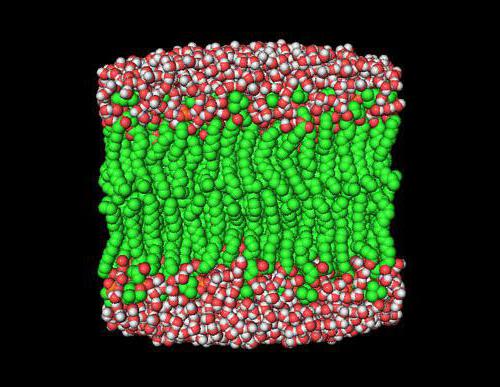Fats are one of the most important organic substances that all living things need. In this article, we consider the structure and functions of lipids. They are diverse in both structure and function.
The structure of lipids (biology)
Lipid is a complex organic chemical compound. It consists of several components. Let's look at the structure of lipids in more detail.
Simple lipids
The structure of lipids in this group provides for the presence of two components: alcohol and fatty acids. Typically, the chemical composition of such substances includes only three elements: carbon, hydrogen and oxygen.
Varieties of Simple Lipids
They are divided into three groups:
- Alkyl acylates (waxes). These are esters of higher fatty acids and mono- or dihydric alcohols.
- Triacylglycerols (fats and oils). The structure of lipids of this type provides for the presence in the composition of glycerol (trihydric alcohol) and residues of higher fatty acids.
- Ceramides. Esters of sphingosine and fatty acids.
Complex lipids
Substances in this group do not consist of three elements. In addition to them, they most often include sulfur, nitrogen and phosphorus in their composition.
Classification of complex lipids
They can also be divided into three groups:
- Phospholipids. The structure of lipids of this group provides, in addition to the residues of polyhydric alcohols and higher fatty acids, the presence of phosphoric acid residues, to which additional groups of various elements are attached.
- Glycolipids. These are chemicals produced by combining lipids with carbohydrates.
- Sphingolipids. These are derivatives of aliphatic amino alcohols.
The first two types of lipids, in turn, are divided into subgroups.
So, phosphoglycerolipids (containing glycerol, the residues of two fatty acids, phosphoric acid and amino alcohol), cardiolipins, plasmalogens (containing unsaturated monohydric higher alcohol, phosphoric acid and amino alcohol) and sphingomyelins (substances that are from sphingosine, fatty acid, phosphoric acid and amino alcohol choline).
Types of glycolipids include cerebrosides (except sphingosine and fatty acids, contain galactose or glucose), gangliosides (contain an oligosaccharide from hexoses and sialic acids) and sulfatides (sulfuric acid is attached to hexose).
The role of lipids in the body
The structure and functions of lipids are interconnected. Due to the fact that their molecules simultaneously contain polar and nonpolar structural fragments, these substances can function at the phase boundary.
Lipids have eight main functions:
- Energy. Due to the oxidation of these substances, the body receives more than 30 percent of all the energy it needs.
- Structural. The structural features of lipids allow them to be an important component of the membranes. They are part of membranes, line various organs, form membranes of nerve tissues.
- Reserving. These substances are a form of conservation of fatty acids by the body.
- Antioxidant. The structure of lipids allows them to perform such a role in the body.
- Regulatory. Some lipids mediate hormones in cells. In addition, some hormones are formed from lipids, as well as substances that stimulate immunogenesis.
- Protective. The subcutaneous layer of fat provides thermal and mechanical protection for the animal. As for plants, a protective shell forms on the surface of leaves and fruits from waxes.
- Informational. Lipids gangliosides provide contacts between cells.
- Digestive Bile acids are formed from cholesterol lipid , which are involved in the digestion of food.

The synthesis of lipids in the body
Most substances of this class are synthesized in a cell from the same starting material - acetic acid. Hormones such as insulin, adrenaline and pituitary hormones regulate fat metabolism.
There are also lipids that the body is not able to produce on its own. They must be ingested with food. They are mainly found in vegetables, fruits, herbs, nuts, cereals, sunflower and olive oils and other vegetable products.
Vitamin Lipids
Some vitamins by their chemical nature belong to the class of lipids. These are vitamins A, D, E and K. They must be ingested with food.
The role of lipid vitamins in the body| Vitamin | Functions | Manifestation of a deficiency | Sources |
| Vitamin A (Retinol) | Participates in the growth and development of epithelial tissue. It is part of rhodopsin, a visual pigment. | Dry and peeling skin. Visual impairment in low light. | Liver, spinach, carrots, parsley, red pepper, apricots. |
| Vitamin K (phylloquinone) | Participates in the metabolism of calcium. It activates the proteins responsible for blood coagulation, takes part in the formation of bone tissue. | Cartilage ossification, blood clotting, salt deposition on the walls of blood vessels, bone deformation. Vitamin K deficiency is very rare. | It is synthesized by intestinal bacteria. Also found in lettuce, nettle, spinach, cabbage. |
| Vitamin D (Calciferol) | It takes part in the exchange of calcium, the formation of bone tissue and tooth enamel. | Rickets | Fish oil, egg yolk, milk, butter. It is synthesized in the skin under the influence of ultraviolet radiation. |
| Vitamin E (tocopherol) | It stimulates the immune system. Participates in tissue regeneration. Protects cell membranes from damage. | Increased permeability of cell membranes, decreased immunity. | Vegetables, vegetable oils. |
So we examined the structure and properties of lipids. Now you know what these substances are, what are the differences between different groups, what role lipids play in the human body.
Conclusion
Lipids are complex organic substances that are divided into simple and complex. They perform eight functions in the body: energy, storage, structural, antioxidant, protective, regulatory, digestive and informational. In addition, there are lipid vitamins. They perform many biological functions.